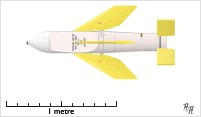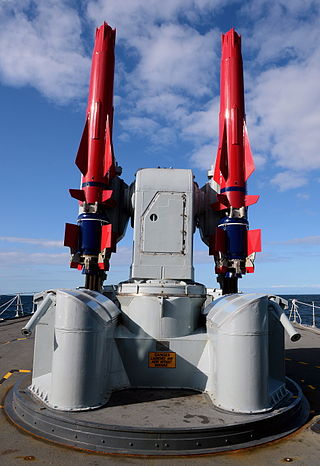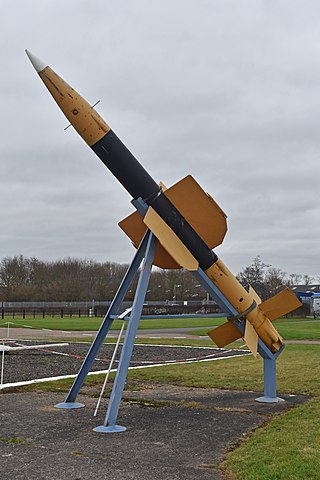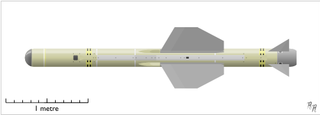Related Research Articles

A surface-to-air missile (SAM), also known as a ground-to-air missile (GTAM) or surface-to-air guided weapon (SAGW), is a missile designed to be launched from the ground or the sea to destroy aircraft or other missiles. It is one type of anti-aircraft system; in modern armed forces, missiles have replaced most other forms of dedicated anti-aircraft weapons, with anti-aircraft guns pushed into specialized roles.

The County class was a class of British guided missile destroyers, the first such warships built by the Royal Navy. Designed specifically around the Seaslug anti-aircraft missile system, the primary role of these ships was area air defence around the aircraft carrier task force in the nuclear-war environment.

HMS Glamorgan was a County-class destroyer of the Royal Navy with a displacement of 5,440 tonnes. The ship was built by Vickers-Armstrongs in Newcastle Upon Tyne and named after the Welsh county of Glamorgan.

HMS Hampshire was a County-class destroyer of the Royal Navy. Laid down, in March 1959 a couple of weeks behind the class leader Devonshire, she was classified as a guided missile destroyer, as the Sea Lords regarded the concept of the cruiser and big gun ship as discredited by the perceived failure of the Tiger class and the obsolescence of the heavy gun. The description of guided missile destroyer seemed more likely to win approval from the Treasury and Government for an adequate number of warships the size of small cruisers, which could play many traditional cruiser flagship and command functions, but had no armour around its gun and missile magazine.

HMS Kent was a batch-1 County-class destroyer of the Royal Navy. She and her sisters were equipped with the Sea Slug Mk-1 medium-range surface-to-air missile SAM system, along with the short-range Sea Cat SAM, two twin 4.5-inch gun turrets, two single 20mm cannon, ASW torpedo tubes, and a platform and hangar that allowed her to operate one Wessex helicopter. The County class were large ships, with good seakeeping abilities and long range, and were ideal blue-water ships for their time.

Seacat was a British short-range surface-to-air missile system intended to replace the ubiquitous Bofors 40 mm gun aboard warships of all sizes. It was the world's first operational shipboard point-defence missile system, and was designed so that the Bofors guns could be replaced with minimum modification to the recipient vessel and (originally) using existing fire-control systems. A mobile land-based version of the system was known as Tigercat.
Fairey's Green Cheese, a rainbow code name, was a British-made radar-guided anti-ship missile project of the 1950s. It was a development of the earlier and much larger Blue Boar television guided glide bomb, making it smaller, replacing the television camera with the radar seeker from the Red Dean air-to-air missile, and carrying a smaller warhead of 1,700 pounds (770 kg).

Sea Dart, or GWS.30 was a Royal Navy surface-to-air missile system designed in the 1960s and entering service in 1973. It was fitted to the Type 42 destroyers, Type 82 destroyer and Invincible-class aircraft carriers of the Royal Navy. Originally developed by Hawker Siddeley, the missile was built by British Aerospace after 1977. It was withdrawn from service in 2012.

Seaslug was a first-generation surface-to-air missile designed by Armstrong Whitworth for use by the Royal Navy. Tracing its history as far back as 1943's LOPGAP design, it came into operational service in 1961 and was still in use at the time of the Falklands War in 1982.

The Hawker Siddeley Red Top was the third indigenous British air-to-air missile to enter service, following the de Havilland Firestreak and limited-service Fireflash. It was used to replace the Firestreak on the de Havilland Sea Vixen and later models of the English Electric Lightning.

The BAe Sea Eagle is a medium-weight sea-skimming anti-ship missile designed and built by BAe Dynamics. It is designed to sink or disable ships up to the size of aircraft carriers in the face of jamming and other countermeasures including decoys. Its users include the Royal Air Force and Royal Navy, the Royal Saudi Air Force, and the Indian Navy.

The Sea Skua is a British lightweight short-range air-to-surface missile (ASM) designed for use from helicopters against ships. It was primarily used by the Royal Navy on the Westland Lynx. Although the missile is intended for helicopter use, Kuwait employs it in a shore battery and on their Umm Al Maradem fast attack craft.
The Rainbow Codes were a series of code names used to disguise the nature of various British military research projects. They were mainly used by the Ministry of Supply from the end of the Second World War until 1958, when the ministry was broken up and its functions distributed among the forces. The codes were replaced by an alphanumeric code system.

Red Dean, a rainbow code name, was a large air-to-air missile developed for the Royal Air Force during the 1950s. Originally planned to use an active radar seeker to offer all-aspect performance and true fire-and-forget engagements, the valve-based electronics demanded a missile of prodigious size.
Blue Envoy was a British project to develop a ramjet-powered surface-to-air missile. It was tasked with countering supersonic bomber aircraft launching stand-off missiles, and thus had to have very long range and high-speed capabilities. The final design was expected to fly at Mach 3 with a maximum range of over 200 miles (320 km).

The AAM-N-5 Meteor was an early American air-to-air missile, developed by the Massachusetts Institute of Technology and Bell Aircraft for the United States Navy. Initially, both air-launched and ship-launched versions were considered. Versions designed for launch from carrier-based aircraft proceeded to the flight testing stage before the project was cancelled.
The SSM-N-2 Triton was a supersonic nuclear land-attack cruise missile project for the United States Navy. It was in development from 1946 to 1957, but probably no prototypes were produced or tested. The Triton program was approved in September 1946, designated SSM-2 a year later, and redesignated SSM-N-2 in early 1948. A preliminary design was produced by 1950 as the XSSM-N-2, but was scaled down by 1955 and redesigned again in 1957. Triton was cancelled in 1957, probably as a result of the 1956 decision to focus the Navy's strategic weapons development on the Polaris submarine-launched ballistic missile. In any case, prototypes of the similar Regulus II missile had already flown, and Triton was redundant, offering only an increase in range from 1,000 nautical miles (1,900 km) to 1,500 nautical miles (2,800 km), which Polaris was about to achieve along with many other advantages. Regulus II was itself cancelled in 1958, although testing of missiles already built continued for several years.

The AAM-N-10 Eagle was a long-range air-to-air missile developed by the Bendix Corporation for use by the United States Navy. Intended for carriage by the Douglas F6D Missileer fleet defense fighter, the Eagle program was cancelled before testing could begin, but the lessons learned were used in the development of the AIM-54 Phoenix missile.
Popsy was a development concept for a small surface-to-air missile (SAM) intended to protect Royal Navy ships from guided bombs and anti-shipping missiles. It was one of several concepts considered for this role, none of which were built. The Orange Nell project took over the role in the 1950s, and was similarly never built. The role was eventually filled by Seacat, a manually-guided system of otherwise similar performance.
Red Hebe was a large active radar homing air-to-air missile developed by Vickers for the Royal Air Force's Operational Requirement F.155 interceptor aircraft. It was a development of the earlier Red Dean, which was not suitable for launch by the new supersonic aircraft. Before progressing much beyond advanced design studies, F.155 was cancelled in the aftermath of the 1957 Defence White Paper which moved Britain's attention from strategic bombers to ballistic missiles. With no other suitable platform, Red Hebe was cancelled as well.
References
Citations
- ↑ Friedman 2012, p. 257.
- 1 2 3 4 5 Gibson & Buttler 2007, p. 64.
- 1 2 Gibson & Buttler 2007, p. 65.
- ↑ Gibson & Buttler 2007, p. 66.
Bibliography
- Gibson, Chris; Buttler, Tony (2007). British Secret Projects: Hypersonics, Ramjets and Missiles. Midland. ISBN 9781857802580.
- Friedman, Norman (2012). British Destroyers & Frigates: The Second World War & After. Seaforth Publishing. ISBN 9781848320154.